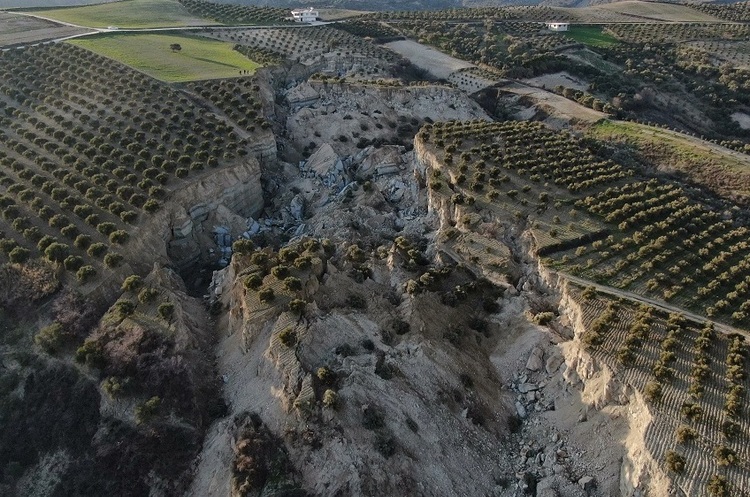Agrarian shift: How Turkey’s disaster will affect the global food market
Agriculture turned out to be the most damaged sector of the Turkish economy – and the whole world, including Ukraine, is going to feel it

Turkey is gradually recovering from the shock of the most powerful earthquake since 1939 and begins to analyse not only the humanitarian but also the economic consequences. A series of strong aftershocks with a magnitude of 7.8 on February 6 hit 10 provinces in the south of the country, which has been generating about 9% of GDP.
The death toll is still being finalised, but has already exceeded 35,000 people. 13.5 million people, 15.7% of Turkey's population, were affected.
According to rough estimates, the cost of destroyed apartments alone is $6.3 billion, and $10 billion if non-residential buildings are taken into account. According to Bloomberg estimates, the crisis could cost the country, whose economy reached $862 billion in 2022, 5.5% of GDP.
Official data on Turkey's economic growth for 2022 will be released at the end of February. It is expected to fall in the range of 6 to 7%. The forecast for 2023 was 5%, but taking into account the consequences of the earthquake, experts believe that a 3% economic growth rate is more realistic. This will result in the state budget deficit, which is projected at 3.5% of GDP in 2023, likely to rise to 5% of GDP.
At the same time, the structure of the economic damage is uneven across industries. It is symbolic that the footage of the tectonic fault that has spread around the world goes through an olive grove. It is agriculture that has taken a sad lead among the losses from the cataclysm. But the outside world will also feel the consequences of this damage, as Turkey, which has the fourth largest economy in Europe, is an active exporter and importer of food products.
Mind analysed how the Turkish disaster's consequences are going to affect the region's economy and whether Ukraine could be significantly struck.
Are the losses evenly distributed across the affected provinces? No, the amount of losses is derivative from the economic potential at the time of the disaster.
Gaziantep province, whose capital of the same name is the sixth largest city in Turkey, had the largest share. It is a significant trade centre and industrial hub, with high (in some cases, leading) positions in the country's textile, food and chemical industries. Cement plants, silk weaving and textile factories are located in the province.
Gaziantep exports goods to more than 40 countries.
Why did the agricultural sector suffer the most from the disaster in economic terms? First of all, due to the importance of this industry for Turkey.
The share of agriculture is estimated at 6.6% of GDP, but this is deceptive modesty. According to the World Bank, about half of the country's territory is occupied by agriculture, and about one in five Turkish citizens is employed in this industry.
The ten affected provinces account for 15% of total agricultural GDP and form a powerful agricultural hub. Also, due to the strategic location of these provinces, many large cities, including Istanbul, are "powered" by them.
Oxford Economics predicts that global short-term disruptions in the provinces will reduce the country's GDP by 0.3-0.4%.
What are the risks in terms of agricultural sectors? According to Turkish media, the total production of agricultural crops in the earthquake zone is as follows:
- wheat – 2.9 mln tonnes, 20.3% of Turkey's gross harvest;
- corn (grain) – 2.7 mln tonnes, 40.2%;
- corn (silage) – 2.6 mln tonnes, 9.7%;
- barley – 653,000 tonnes, 11.9%;
- cotton – 1.6 mln tonnes, 71.2%;
- Watermelon – 1.1 mln tonnes, 31.9%;
- mandarin – 736,000 tonnes, 80.7%.
Total number of animals in the affected provinces:
- Chicken for meat – 15 mln animal units, 5.5% of the total population of Turkey;
- laying hens – 11 mln units, 9%;
- sheep – 672,000 units, 16.3%;
- goats (woollen and other breeds) – 2.6 million units, 21.5%;
- ñattle – 1.1 mln units, 14.8%;
- turkeys – 563,800 units, 12%;
- geese –109,400 units, 7.4%.
Did the affected provinces play a significant role in Turkey's national exports? Yes.
In 2022, exports from 10 provinces reached $21.5 billion, which is 8.5% of all Turkish exports. Gaziantep accounted for half of the total volume.
Hatay Province has a seaport connecting the Middle East ($4.1 billion in exports) and Adana ($3.1 billion in exports).
What is the connection with inflation? Turkey's President Recep Tayyip Erdogan has a loose monetary policy, which means that prices are not limited. This has already provided the country with one of the highest inflation rates in the world.
Declining agricultural supplies, in turn, could trigger food inflation, which was 71% in January.
Was the agricultural sector specifically supported? Yes, but it is unknown whether it is comparable to the scale of the tragedy.
The Turkey's Ministry of Agriculture and Forestry has sent 750 animal tents to the affected regions, and this number will be increased to 4000. Of these, 2000 tents have a capacity of 18 cattle and 32 sheep and goats. The other 2000 tents can accommodate nine cattle animals and 16 sheep.
We have also sent 1700 tonnes of compound animal feedstuff to the affected regions.
How will the Turkish crisis be felt globally? Turkey is the largest producer of certain types of nuts (e.g., hazelnuts), whose orchards were concentrated in the earthquake zone. Accordingly, prices for this product may rise. Exports of fruits and vegetables from the affected provinces will inevitably slow down.
Turkey's dependence on food imports will also increase.
What should Ukraine expect? The key issue – the operation of the "grain corridor" – is unlikely to be aggravated by the disaster, as the Bosporus ports were not affected. Given the general chaos, there may be an even greater slowdown in inspections and communications in the Coordination Centre, but it is unlikely to be significant.
Read also: Ammonia-flavoured grain: what russia got for extending the Istanbul Agreement
However, Turkey's need for food imports – in particular, wheat and flour, previously covered by Ukraine, – is likely to increase. And the country that claims to be a peacekeeper and de facto controls Ukraine's sea grain exports can offer to cover it on its own terms, i.e., on preferential ones.
If you have read this article to the end, we hope that means it was useful for you.
We work to ensure that our journalistic and analytical work is of high quality, and we strive to perform it as competently as possible. This also requires financial independence. Support us for only UAH 196 per month.
Become a Mind subscriber for just USD 5 per month and support the development of independent business journalism!
You can unsubscribe at any time in your LIQPAY account or by sending us an email: [email protected]


